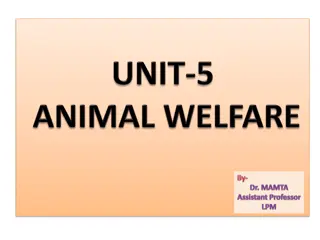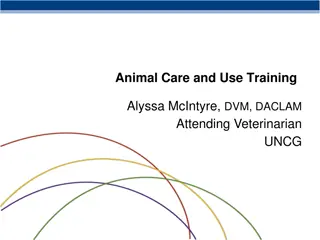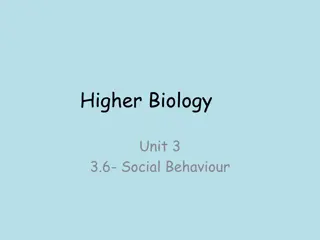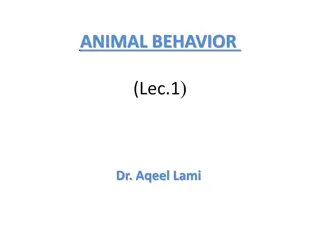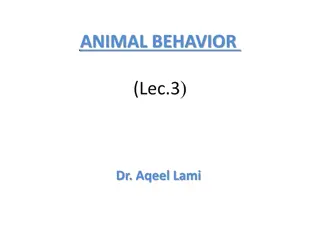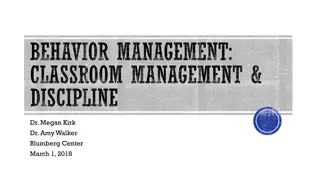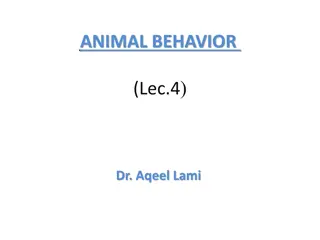Animal Behavior: Instincts, Learning, and Social Interactions
Explore the intricate world of animal behavior, delving into instinctual reflexes at birth, learning processes such as habituation and conditioning, and the diverse types of behaviors animals exhibit, from sexual and maternal instincts to communicative and social interactions. Gain insights into how animals navigate their environments through innate behaviors and learned responses.
Download Presentation

Please find below an Image/Link to download the presentation.
The content on the website is provided AS IS for your information and personal use only. It may not be sold, licensed, or shared on other websites without obtaining consent from the author. Download presentation by click this link. If you encounter any issues during the download, it is possible that the publisher has removed the file from their server.
E N D
Presentation Transcript
TERMS TO KNOW Instinct (reflexes and responses) what the animal has at birth. Ex. Nursing, searching for food. Habituation learning to respond without thinking, response to certain stimulus is established as a result of habituation. Conditioning learning to respond in a particular way to a stimulus as a result of reinforcement when the proper response is made.
TERMS TO KNOW Reinforcement a reward for making the proper response. Reasoning the ability to respond correctly to a stimulus the first time that a new situation is presented. Intelligence the ability to learn to adjust successfully to certain situations. Both short-term and long-term memory are part of intelligence.
MAJOR TYPES OF ANIMAL BEHAVIOR Sexual Maternal Communicative Social Feeding Eliminative Shelter-Seeking Investigative Allelomimetic Maladaptive
SEXUAL BEHAVIOR Useful in implementing breeding programs Cows that are in heat, allow themselves to be mounted by others Bulls, rams and stallions smell the vagina and urine to detect pheromones Flehmen Male animal lifts head and curls its upper lip Rams chase ewes that are coming into heat Sows seek out boars for mating Mares in heat squat and urinate when stallion approaches and vulva winks
MATERNAL BEHAVIOR Females taking care of newborn and young animals Mothers clean young by licking them Mothers fight off intruders Become aggressive in protecting they young after birth
COMMUNICATIVE BEHAVIOR When some type of information is exchanged between individual animals Distress Calls Lambs bleat, calves bawl, pigs squeal and chicks chirp Dams recognize offspring by smell Farm animals respond to calls or whistles of the producer Bulls bellow deeply to communicate aggressive behavior
SOCIAL BEHAVIOR Includes fight or flight and aggressive and passive behaviors between animals Includes interactions with other animals, humans and behavior during handling and restraint Males of all farm animals fight when they meet other unfamiliar males of the same species Cows, sows and mares develop a pecking order, but fight less intensely than males Cows withdraw from the herd to a secluded spot just before calving Almost all animals withdraw from the herd if they are sick
FEEDING BEHAVIOR Exhibited by animals when eating and drinking (Ingestive Behavior) Cattle graze 4-9hrs/day, ruminate 4-9hrs/day, regurgitate 300- 400 boluses of feed per day Sheep and goats graze 9-11hrs/day, ruminate 7-10hrs/day, regurgitate 400-600 boluses of feed per day Cattle usually don t go more than 3 miles away from water Sheep may travel as much as 8 miles a day
ELIMINATIVE BEHAVIOR Elimination of feces and urine Cattle, sheep, horses, goats and chickens eliminate feces & urine indiscriminately Hogs eliminate feces in definite areas of a pasture or pen Cattle, sheep, goats and swine defecate while standing or walking, urinate while standing, but not walking Cattle defecate 12-18 times/day, urinate 7-11 times/day Horses defecate 5-12 times/day, urinate 7-11 times/day Animals defecate & urinate more when stressed or excited Animals loose 3% of their live weight when transported to & from market points (Shrink)
SHELTER-SEEKING BEHAVIOR Animals crowd together in snow and cold winds Animals seek shelter of trees when it rains Cattle and sheep seek shady area for rest and rumination if weather is hot Hogs find a wet area if weather is hot In extreme situations, animals pile up to the extent that some get smothered
INVESTIGATIVE BEHAVIOR Pigs, horses and dairy goats are highly curious, investigate any strange object, approach carefully, slowly, sniffing and looking as they approach Sheep are less curious and more timid
ALLELOMIMETIC Animals of a species tend to do the same thing at the same time Important in that a producer may observe the herd with little difficulty, also useful in driving groups of animals from one place to another Cattle and sheep tend to graze at the same time and rest and ruminate at the same time Range cattle gather at the watering place about the same time each day because one follows the other
MALADAPTIVE BEHAVIOR Animals that cannot adapt to their environment, exhibit inappropriate or unusual behavior Chickens and swine in extensive management (confinement) systems resort to cannibalism, removal of tails is a prevention method Buller-steer syndrome steers that have been castrated before puberty demonstrate masculine behavior




